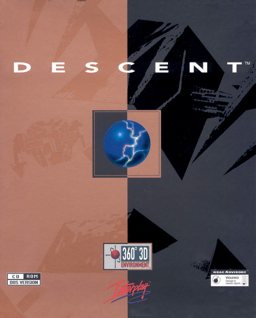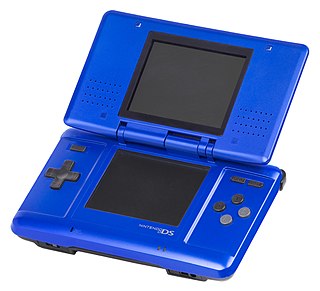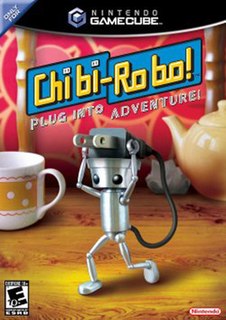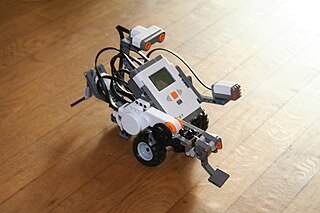
A video game or computer game is an electronic game that involves interaction with a user interface or input device – such as a joystick, controller, keyboard, or motion sensing device – to generate visual feedback. This feedback mostly commonly is shown on a video display device, such as a TV set, monitor, touchscreen, or virtual reality headset. Some computer games do not always depend on a graphics display, for example text adventure games and computer chess can be played through teletype printers. Video games are often augmented with audio feedback delivered through speakers or headphones, and sometimes with other types of feedback, including haptic technology.
The graphical user interface is a form of user interface that allows users to interact with electronic devices through graphical icons and audio indicator such as primary notation, instead of text-based UIs, typed command labels or text navigation. GUIs were introduced in reaction to the perceived steep learning curve of command-line interfaces (CLIs), which require commands to be typed on a computer keyboard.

A handheld game console, or simply handheld console, is a small, portable self-contained video game console with a built-in screen, game controls and speakers. Handheld game consoles are smaller than home video game consoles and contain the console, screen, speakers, and controls in one unit, allowing people to carry them and play them at any time or place.

Descent is a first-person shooter (FPS) game developed by Parallax Software and released by Interplay Productions in 1995 for MS-DOS, and later for Macintosh, PlayStation, and RISC OS. It popularized a subgenre of FPS games employing six degrees of freedom and was the first FPS to feature entirely true-3D graphics. The player is cast as a mercenary hired to eliminate the threat of a mysterious extraterrestrial computer virus infecting off-world mining robots. In a series of mines throughout the Solar System, the protagonist pilots a spaceship and must locate and destroy the mine's power reactor and escape being caught in the mine's self-destruction, defeating opposing robots along the way. Players can play online and compete in either deathmatches or cooperate to take on the robots.
A virtual pet is a type of artificial human companion. They are usually kept for companionship or enjoyment. People may keep a digital pet in lieu of a real pet. Cyberpet and Tamagotchi were some of the first popular digital pets.

The Nintendo DS is a handheld game console produced by Nintendo, released globally across 2004 and 2005. The DS, an initialism for "Developers' System" or "Dual Screen", introduced distinctive new features to handheld games: two LCD screens working in tandem, a built-in microphone and support for wireless connectivity. Both screens are encompassed within a clamshell design similar to the Game Boy Advance SP. The Nintendo DS also features the ability for multiple DS consoles to directly interact with each other over Wi-Fi within a short range without the need to connect to an existing wireless network. Alternatively, they could interact online using the now-defunct Nintendo Wi-Fi Connection service. Its main competitor was Sony's PlayStation Portable during the seventh generation of video game consoles.

In computing, a visual programming language is any programming language that lets users create programs by manipulating program elements graphically rather than by specifying them textually. A VPL allows programming with visual expressions, spatial arrangements of text and graphic symbols, used either as elements of syntax or secondary notation. For example, many VPLs are based on the idea of "boxes and arrows", where boxes or other screen objects are treated as entities, connected by arrows, lines or arcs which represent relations.

Chibi-Robo! is a platform-adventure video game for the GameCube developed by Bandai and Skip Ltd. and published by Nintendo. The game was released in Japan in 2005, and in North America and Europe the following year. Originally conceived as a point-and-click adventure game, it was put on developmental hold until Nintendo producer Shigeru Miyamoto gained interest in the title and overhauled its production.

Digital signage is a segment of electronic signage. Digital displays use technologies such as LCD, LED, projection and e-paper to display digital images, video, web pages, weather data, restaurant menus, or text. They can be found in public spaces, transportation systems, museums, stadiums, retail stores, hotels, restaurants and corporate buildings etc., to provide wayfinding, exhibitions, marketing and outdoor advertising. They are used as a network of electronic displays that are centrally managed and individually addressable for the display of text, animated or video messages for advertising, information, entertainment and merchandising to targeted audiences.

Dolphin is a free and open-source video game console emulator for GameCube and Wii that runs on Windows, Linux, MacOS, and Android.

Lego Mindstorms NXT is a programmable robotics kit released by Lego on August 2, 2006. It replaced the first-generation Lego Mindstorms kit, which was called the Robotics Invention System. The base kit ships in two versions: the Retail Version and the Education Base Set. It comes with the NXT-G programming software, or optionally LabVIEW for Lego Mindstorms. A variety of unofficial languages exist, such as NXC, NBC, leJOS NXJ, and RobotC. The second generation of the set, the Lego Mindstorms NXT 2.0, was released on August 1, 2009, featuring a color sensor and other upgraded capabilities. The third generation, the EV3, was released in September 2013.
User experience design is the process of creating evidence-based, interaction designs between human users and products or websites. Design decisions in UX design are driven by research, data analysis, and test results rather than aesthetic preferences and opinions. Unlike user interface design, which focuses solely on the design of a computer interface, UX design encompasses all aspects of a user's perceived experience with a product or website, such as its usability, usefulness, desirability, brand perception, and overall performance. UX design is also an element of the customer experience (CX), which encompasses all aspects and stages of a customer's experience and interaction with a company.

Portal 2 is a 2011 puzzle-platform video game developed by Valve for Windows, Mac OS X, Linux, PlayStation 3, and Xbox 360. The digital PC version is distributed online by Valve's Steam service, while all retail editions were distributed by Electronic Arts. A port for the Nintendo Switch was included as part of Portal: Companion Collection.

The Japanese multinational consumer electronics company Nintendo has developed seven home video game consoles and multiple portable consoles for use with external media, as well as dedicated consoles and other hardware for their consoles. As of September 30, 2021, in addition to Nintendo Switch, Nintendo has sold over 863.07 million hardware units.
This is a list of GameCube accessories.
Siftables are small computers that display graphics on their top surface and sense one another and how they are being moved. Siftables were developed as a platform for hands-on interactions with digital information and media and were the prototype for Sifteo cubes.
Vortex Studio is a complete simulation software platform. It features a high-fidelity, realtime physics engine developed by CM Labs Simulations that simulates rigid body dynamics, collision detection, contact determination, and dynamic reactions. It also contains model import and preparation tools, an image generator, and networking tools for distributed simulation, accessed through a desktop editor via a GUI. Vortex adds accurate physical motion and interactions to objects in visual-simulation applications for operator training, mission planning, product concept validation, heavy machinery and robotics design and testing, haptics devices, immersive and virtual reality (VR) environments.
Swinxs is a portable game console for children between the ages of 4-12 years. The screen-free console was marketed as suitable for in-and-outdoor play and used RFID technology, audio, and light as a replacement for a monitor. Games for the console typically have users engage in physical or educational play by using its synthesized voice in combination with other sounds and a light.

Red Eclipse is an open-source first-person shooter that is forked from Cube 2: Sauerbraten. Like the original Cube 2, it features multiplayer gameplay as well as in-game level editing, but with improved graphics and a focus on parkour movement. The game is free and open-source software, released under the zlib license, and developed by an open community of contributors. Its content is free, and released under a CC-BY-SA license.













